A Preliminary Snapshot Investigation of the Marine Soundscape for Malta: A Steppingstone towards Achieving ‘Good Ecological Status’
Abstract
:1. Introduction
2. Materials and Methods
2.1. Data Collection
2.2. Data Extraction, Visualisation and Processing
2.3. FFTs, Spectrograms and Power Spectral Density Analysis
2.4. Cross-Examination and Analysis of Data between Sites and Seasons
2.5. Identifying Contributors of Underwater Noise through the Use of AIS Data
3. Results
3.1. Analytic Overview of Audio Data Recorded at Ċirkewwa and the Grand Harbour
3.2. Ċirkewwa
3.3. The Grand Harbour
4. Discussion
5. Conclusions
Author Contributions
Funding
Institutional Review Board Statement
Informed Consent Statement
Data Availability Statement
Acknowledgments
Conflicts of Interest
References
- Buscaino, G.; Ceraulo, M.; Pieretti, N.; Corrias, V.; Farina, A.; Filiciotto, F.; Maccarrone, V.; Grammaua, R.; Caruso, F.; Giuseppe, A.; et al. Temporal patterns in the soundscape of the shallow waters of a Mediterranean marine protected area. Sci. Rep. 2016, 6, 34230. [Google Scholar] [CrossRef] [PubMed]
- Merchant, N.D.; Putland, R.L.; André, M.; Baudin, E.; Felli, M.; Slabbekoorn, H.; Dekeling, R. A decade of underwater noise research in support of the European Marine Strategy Framework Directive. Ocean Coast. Manag. 2022, 228, 106–299. [Google Scholar] [CrossRef] [PubMed]
- Pieretti, N.; Lo Martire, M.; Corinaldesi, C.; Musco, L.; Dell’Anno, A.; Danovaro, R. Anthropogenic noise and biological sounds in a heavily industrialized coastal area (Gulf of Naples, Mediterranean Sea). Mar. Environ. Res. 2020, 159, 105002. [Google Scholar] [CrossRef] [PubMed]
- Chang, Y.-C.; Zhang, X. Legal Issues Concerning the Impact of Anthropogenic Underwater Noise in the Marine Environment. Sustainability 2021, 13, 4612. [Google Scholar] [CrossRef]
- Southall, B.L.; Scholik-Schlomer, A.; Hatch, L.; Bergmann, T.; Jasny, M.; Metcalf, K.; Weilgart, L.; Wright, A.J. Underwater Noise from Large Commercial Ships—International Collaboration for Noise Reduction. In Encyclopedia of Maritime and Offshore Engineering; 2017; pp. 1–9. Available online: https://onlinelibrary.wiley.com/doi/full/10.1002/9781118476406.emoe056 (accessed on 29 April 2023).
- Fraschetti, S.; Pipitone, C.; Mararis, A.D.; Rilov, G.; Badalamenti, F.; Bevilacqua, S.; Claudet, J.; Carić, H.; Dahl, K.; D’Anna, G.; et al. Light and shade in marine conservation across European and contiguous seas. Front. Mar. Sci. 2018, 5, 420. [Google Scholar] [CrossRef]
- Directive 2008/56/EC of the European Parliament and of the Council of 17 June 2008 Establishing a Framework for Community Action in the Field of Marine Environmental Policy (Marine Strategy Framework Directive). Available online: https://eur-lex.europa.eu/legal-content/EN/TXT/PDF/?uri=CELEX:02008L0056-20170607&from=PL (accessed on 17 April 2023).
- Diviacco, P.; Nadali, A.; Iurcev, M.; Burca, M.; Carbajales, R.; Gangale, M.; Busato, A.; Brunetti, F.; Grio, L.; Viola, A.; et al. Underwater noise monitoring with real-time and low-cost systems (The CORMA experience). J. Mar. Sci. Eng. 2021, 9, 390. [Google Scholar] [CrossRef]
- Commission Decision (EU) 2017/848 on Laying Down Criteria and Methodological Standards on Good Environmental Status of Marine Waters and Specifications and Standardised Methods for Monitoring and Assessment, and Repealing Decision 2010/477/EU (2017) Official Journal of the European Union L125. Available online: https://eur-lex.europa.eu/legal-content/EN/TXT/PDF/?uri=CELEX:32017D0848 (accessed on 3 March 2023).
- Dekeling, R.P.A.; Tasker, M.L.; Van der Graaf, A.J.; Ainslie, M.A.; Andersson, M.H.; André, M.; Borsani, J.F.; Brensing, K.; Castellote, M.; Cronin, D.; et al. Monitoring Guidance for Underwater Noise in European Seas, Part II: Monitoring Guidance Specifications; Publications Office of the European Union: Luxembourg, 2014. [Google Scholar]
- European Marine Safety Agency (EMSA). Sounds: Status of Underwater Noise from Shipping; European Maritime Safety Agency: Lisbon, Portugal, 2021. [Google Scholar]
- Li, N.; Zhu, H.; Wang, X.; Xiao, R.; Xue, Y.; Zheng, G. Characteristics of very low frequency sound propagation in full waveguides of shallow water. Sensors 2020, 21, 192. [Google Scholar] [CrossRef]
- Erbe, C.; Marley, S.A.; Schoeman, R.P.; Smith, J.N.; Trigg, L.E.; Embling, C.B. The effects of ship noise on marine mammals—A review. Front. Mar. Sci. 2019, 6, 606. [Google Scholar] [CrossRef]
- Erbe, C.; Duncan, A.; Vigness-Raposa, K.J. Introduction to sound propagation under water. In Exploring Animal Behaviour through Sound: Volume 1; Erbe, C., Thomas, J.A., Eds.; Springer: Cham, Switzerland, 2022; pp. 185–216. [Google Scholar]
- Oloruntobi, O.; Mokhtar, K.; Gohari, A.; Asif, S.; Chuah, L.F. Sustainable transition towards greener and cleaner seaborne shipping industry: Challenges and opportunities. Clean. Eng. Technol. 2023, 13, 100628. [Google Scholar] [CrossRef]
- Smith, T.A.; Rigby, J. Underwater radiated noise from marine vessels: A review of noise reduction methods and technology. Ocean Eng. 2022, 266, 112863. [Google Scholar] [CrossRef]
- Schlacke, S.; Maier, N.; Markus, T. Legal implementation of integrated ocean policies: The EU’s marine strategy framework directive. Int. J. Mar. Coast. Law 2011, 26, 59–90. [Google Scholar] [CrossRef]
- Gorjanc, S.; Klančnik, K.; Papadopoulou, N.K.; Murillas-Maza, A.; Jarni, K.; Paramana, T.; Pavičić, M.; Ronchi, F.; Uyarra, M.C.; Koren, Š.; et al. Evaluating the progress in achieving Good Environmental Status in the Mediterranean: A methodology to assess the effectiveness of Marine Strategy Framework Directive’s Programmes of Measures. Mar. Policy 2022, 136, 104889. [Google Scholar] [CrossRef]
- Katsanevakis, S.; Coll, M.; Fraschetti, S.; Giakoumi, S.; Goldsborough, D.; Mačić, V.; Mackelworth, P.; Rilov, G.; Stelzenmüller, V.; Albano, P.G.; et al. Twelve recommendations for advancing marine conservation in European and contiguous seas. Front. Mar. Sci. 2020, 7, 879. [Google Scholar] [CrossRef]
- Rife, A.N.; Erisman, B.; Sanchez, A.; Aburto-Oropeza, O. When good intentions are not enough … Insights on networks of “paper park” marine protected areas. Conserv. Lett. 2012, 6, 200–212. [Google Scholar] [CrossRef]
- Perry, A.L.; Blanco, J.; García, S.; Fournier, N. Extensive use of habitat-damaging fishing gears inside habitat-protecting marine protected areas. Front. Mar. Sci. 2022, 9, 811926. [Google Scholar] [CrossRef]
- La Manna, G.; Picciulin, M.; Crobu, A.; Perretti, F.; Ronchetti, F.; Manghi, N.; Ruiu, A.; Ceccherelli, G. Marine soundscape and fish biophony of a Mediterranean marine protected area. PeerJ 2021, 9, e12551. [Google Scholar] [CrossRef]
- Coll, M.; Piroddi, C.; Steenbeek, J.; Kaschner, K.; Lasram, F.B.R.; Aguzzi, J.; Ballesteros, E.; Bianchi, C.N.; Corbera, J.; Dailianis, T.; et al. The biodiversity of the Mediterranean Sea: Estimates, patterns, and threats. PLoS ONE 2010, 5, e11842. [Google Scholar] [CrossRef]
- Plan Bleu. Maritime Transport in the Mediterranean: Status and Challenges; Plan Bleu: Marseille, France, 2021. [Google Scholar]
- United Nations Conference on Trade and Development (UNCTAD). Review of Maritime Transport 2021; United Nations Publications: Geneva, Switzerland, 2021. [Google Scholar]
- Dailianis, T.; Smith, C.J.; Papadopoulou, N.; Gerovasileiou, V.; Sevastou, K.; Bekkby, T.; Bilan, M.; Billett, D.; Boström, C.; Carreira-Silva, M.; et al. Human activities and resultant pressures on key European marine habitats: An analysis of mapped resources. Mar. Policy 2018, 98, 6. [Google Scholar] [CrossRef]
- Maccarrone, V.; Filiciotto, F.; De Vincenzi, G.; Mazzola, S.; Buscaino, G. An Italian proposal on the monitoring of underwater noise: Relationship between the EU Marine Strategy Framework Directive (MSFD) and marine spatial planning directive (MSP). Ocean Coast. Manag. 2015, 118, 215–224. [Google Scholar] [CrossRef]
- Cavallo, M.; Elliott, M.; Touza, J.; Quintino, V. Benefits and impediments for the integrated and coordinated management of European seas. Mar. Policy 2017, 86, 206–213. [Google Scholar] [CrossRef]
- Rodrigo, F.J.; Ramis, J.; Carbajo, J.; Poveda, P. Underwater anthropogenic noise pollution assessment in shallow waters on the south-eastern coast of Spain. J. Mar. Sci. Eng. 2022, 10, 1311. [Google Scholar] [CrossRef]
- Environment and Resources Authority (ERA). Marine Strategy Framework Directive (2008/56/EC) Malta’s Program of Measures: Summary Report; Environment and Resources Authority: Marsa, Malta, 2017. [Google Scholar]
- Paramana, T.; Katsouras, G.; Dassenakis, M. Assessing the first MSFD implementation cycle in Greece under biodiversity and contaminants descriptors. Water 2021, 13, 3547. [Google Scholar] [CrossRef]
- National Statistics Office (NSO). Transport Statistics 2021—Reference Year: 2020; National Statistics Office: Valletta, Malta, 2021; p. 58. [Google Scholar]
- Environment and Resources Authority (ERA). Conservation Objectives and Measures for Malta’s Marine Natura 2000 Sites; Environment and Resources Authority: Marsa, Malta, 2023. [Google Scholar]
- Environment and Resources Authority (ERA). Natura 2000 Standard Data Form; Environment and Resource Authority: Marsa, Malta, 2019. [Google Scholar]
- Council Directive 92/43/EEC of 21 May 1992 on the Conservation of Natural Habitats and of Wild Fauna and Flora. Available online: https://eur-lex.europa.eu/legal-content/EN/TXT/PDF/?uri=CELEX:31992L0043 (accessed on 7 February 2023).
- Environment and Resources Authority (ERA), Marine Protected Areas. Available online: https://era.org.mt/topic/marine-protected-areas-2/ (accessed on 29 April 2023).
- Martin, K.J.; Alessi, S.C.; Gaspard, J.C.; Tucker, A.D.; Bauer, G.B.; Mann, D.A. Underwater hearing in the loggerhead turtle (Caretta caretta): A comparison of behavioral and auditory evoked potential audiograms. J. Exp. Biol. 2012, 215, 3001–3009. [Google Scholar] [CrossRef]
- Environment and Resources Authority (ERA). Monitoring Factsheet: Underwater Noise; Environment and Resources Authority: Marsa, Malta, 2015. [Google Scholar]
- MarineTraffic—Global Ship Tracking Intelligence. Available online: www.marinetraffic.com (accessed on 9 May 2023).
- Skarsoulis, E.; Piperakis, G.; Prospathopoulos, A.; Makropoulos, D. Prediction of shipping noise in range-dependent environments. J. Mar. Sci. Eng. 2023, 11, 290. [Google Scholar] [CrossRef]
- Malinka, C.; Atkins, J.; Johnson, M.; Tønnesen, P.; Dunn, C.; Claridge, D.; Aguilar de Soto, N.; Madsen, P. An autonomous hydrophone array to study the acoustic ecology of deep-water toothed whales. Deep Sea Res. Part I Oceanogr. Res. Pap. 2020, 158, 103233. [Google Scholar] [CrossRef]
- Sakai, M.; Haga, R.; Tsuchiya, T.; Akamatsu, T.; Umeda, N. Statistical analysis of measured underwater radiated noise from merchant ships using ship operational and design parameters. J. Acoust. Soc. Am. 2023, 154, 1095–1105. [Google Scholar] [CrossRef] [PubMed]
- Lagrois, D.; Chion, C.; Sénécal, J.; Kowalski, C.; Michaud, R.; Vergara, V. Avoiding sharp accelerations can mitigate the impacts of a Ferry’s radiated noise on the St. Lawrence whales. Sci. Rep. 2022, 12, 12111. [Google Scholar] [CrossRef]
- Marshall Day Acoustics. dBWav Version 1.3.4; Marshall Day Acoustics: Auckland, New Zealand, 2019. [Google Scholar]
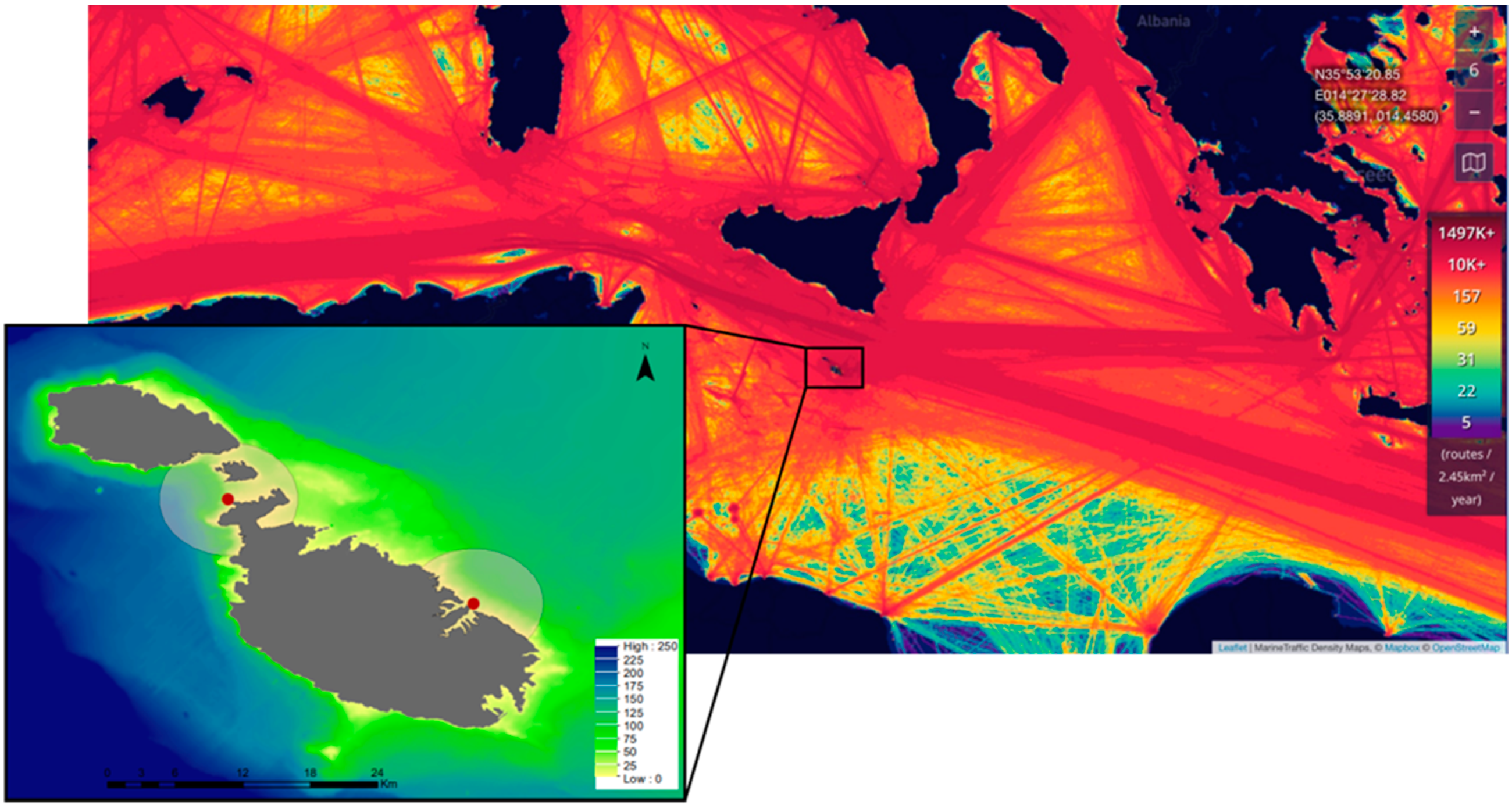
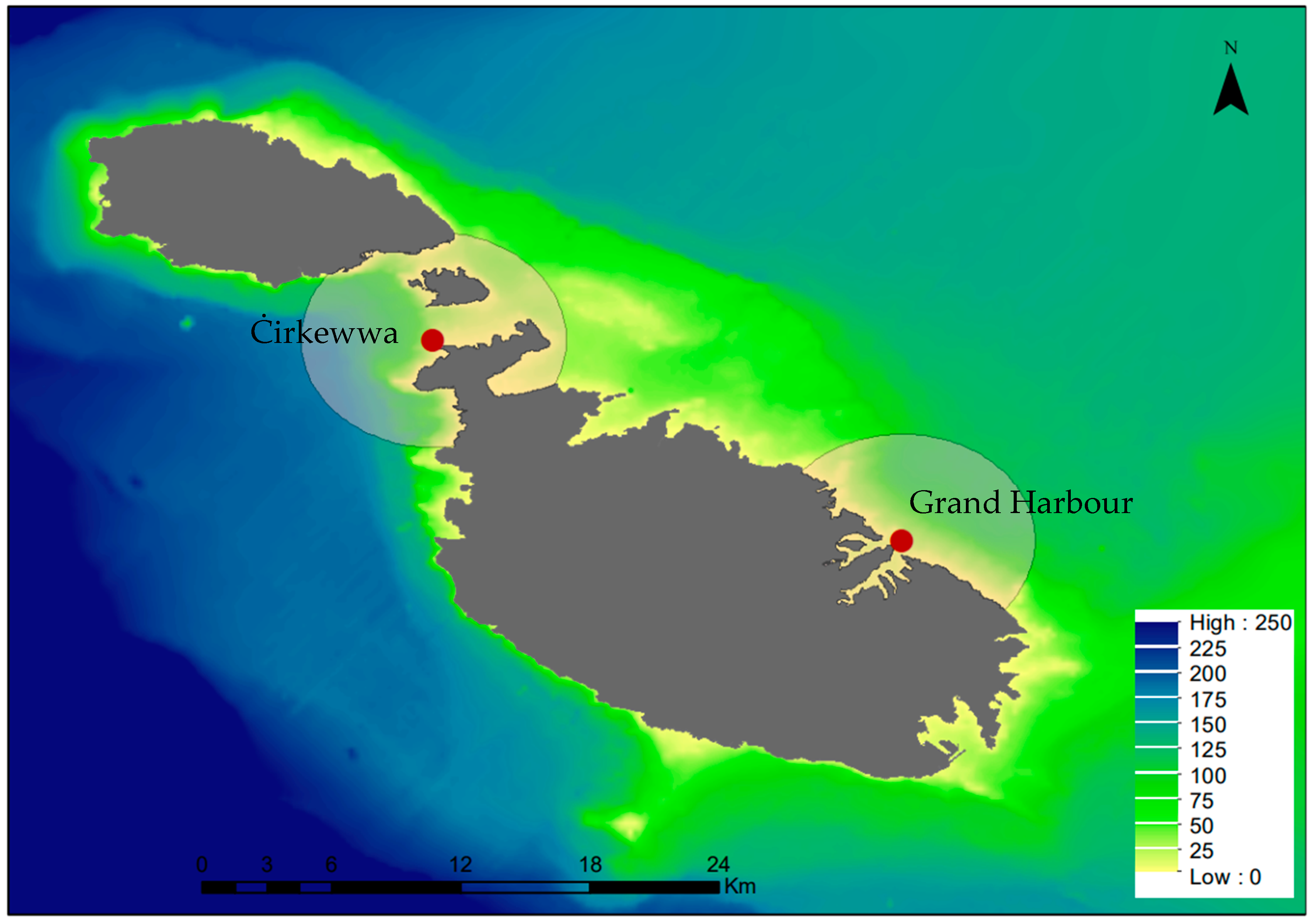

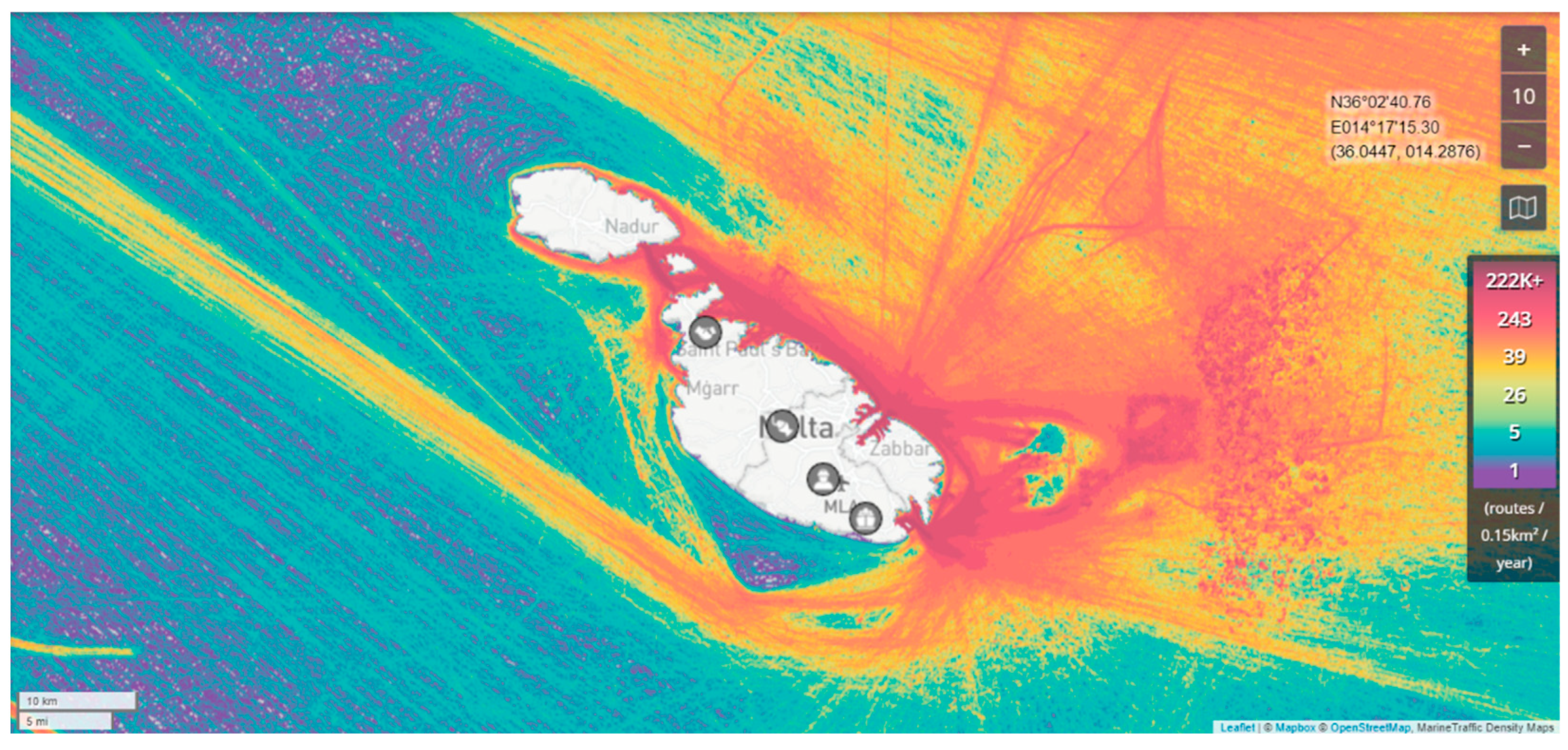
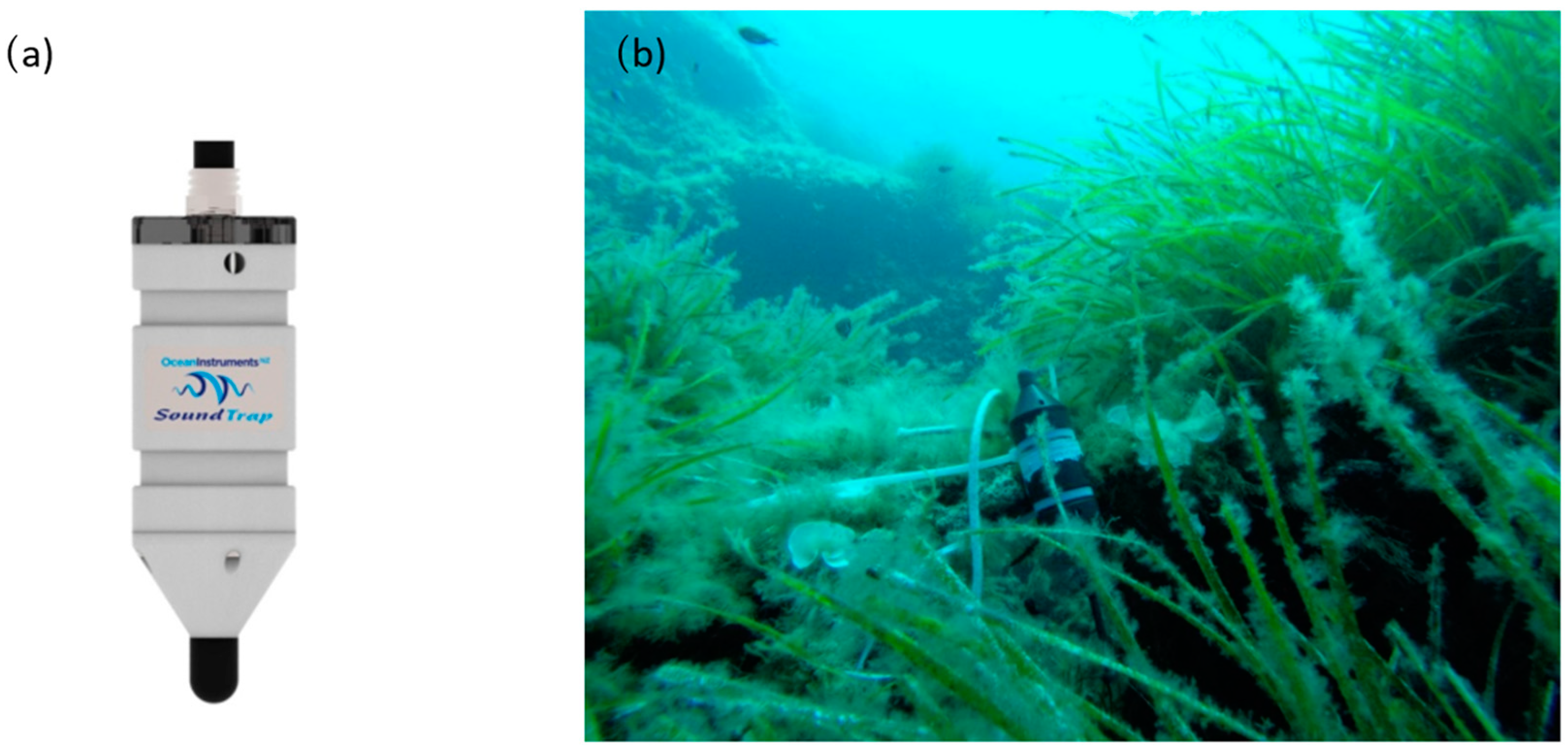

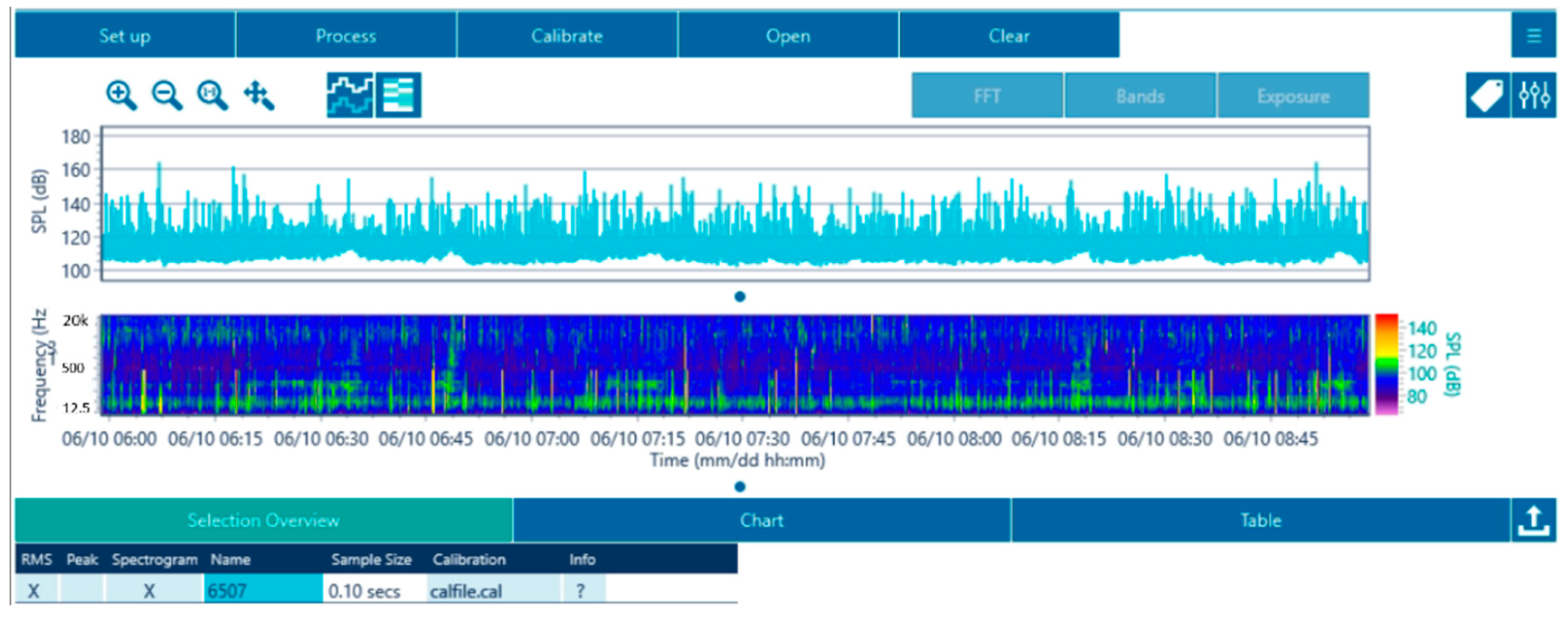
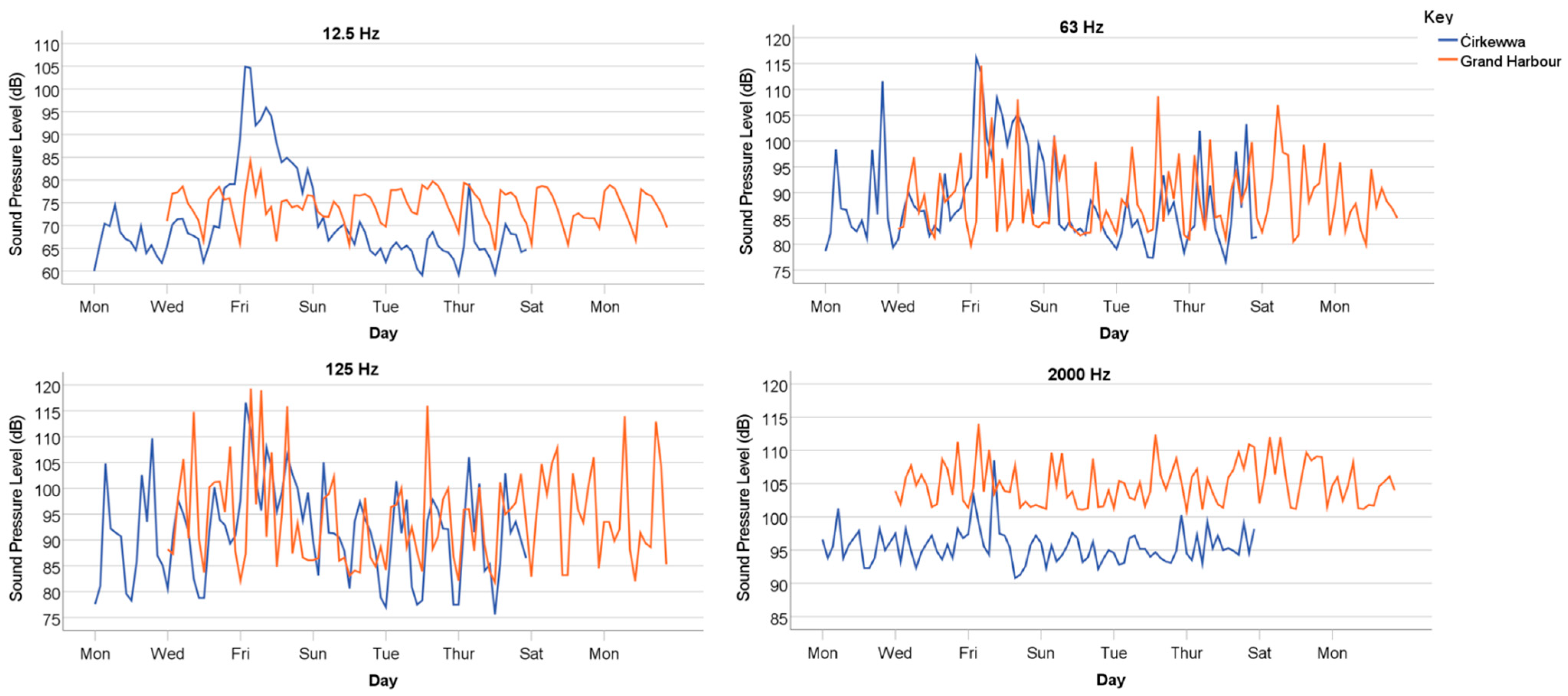
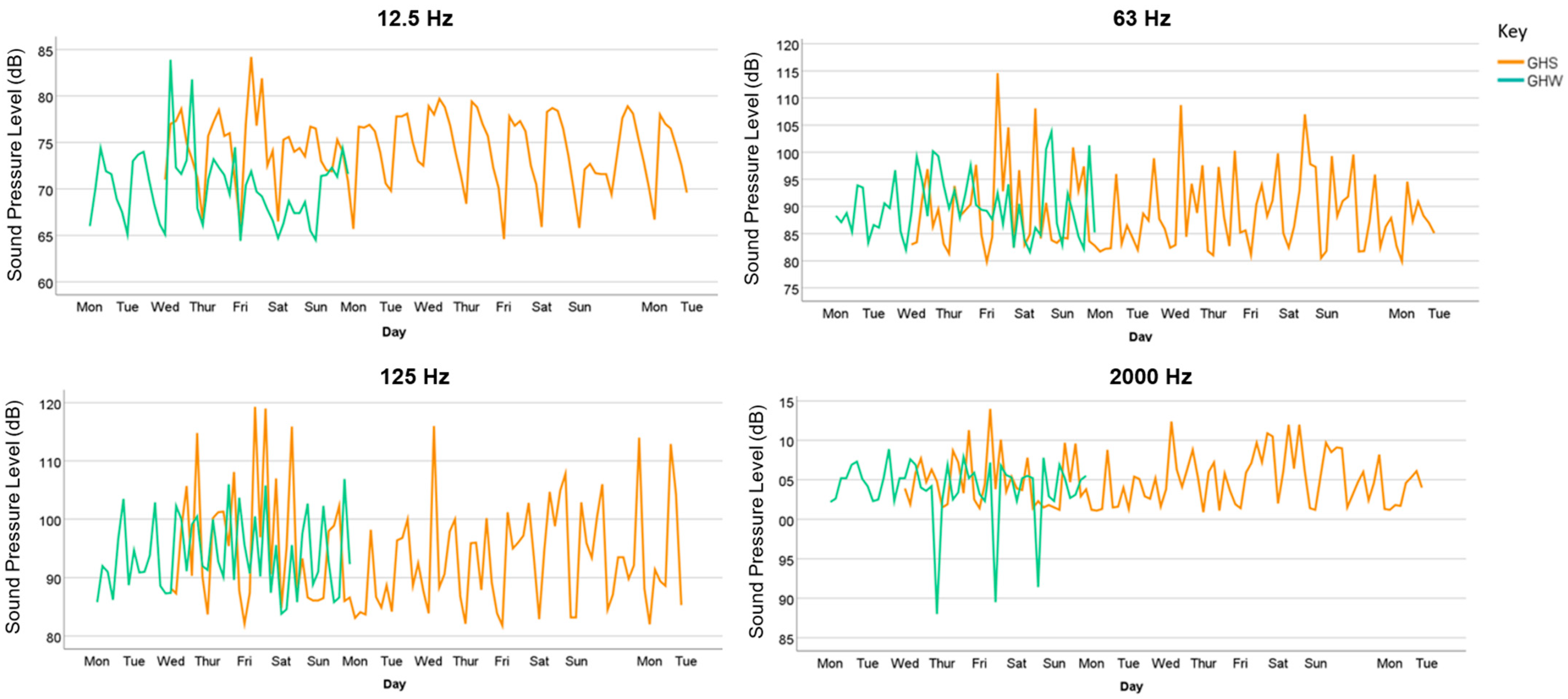
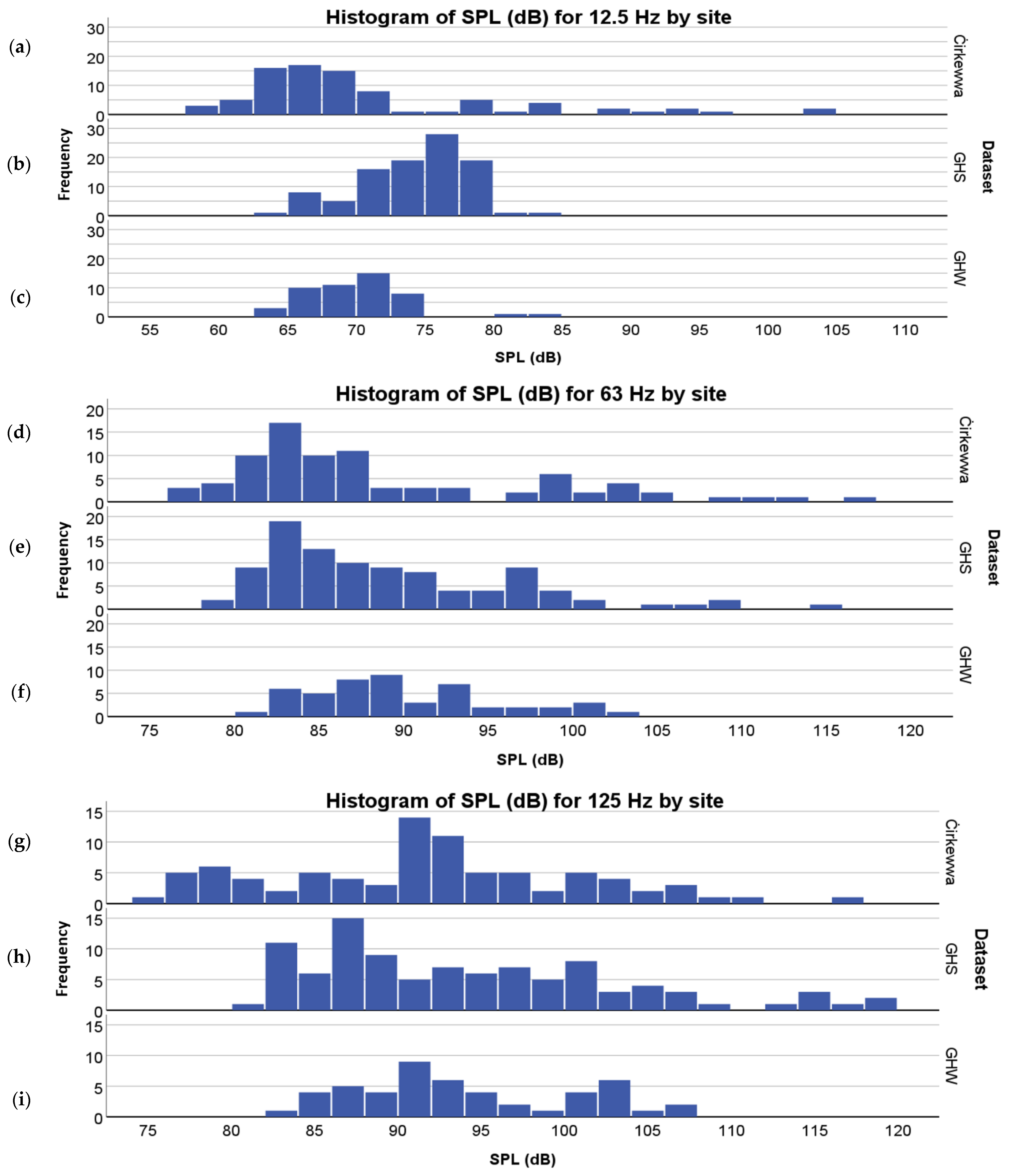
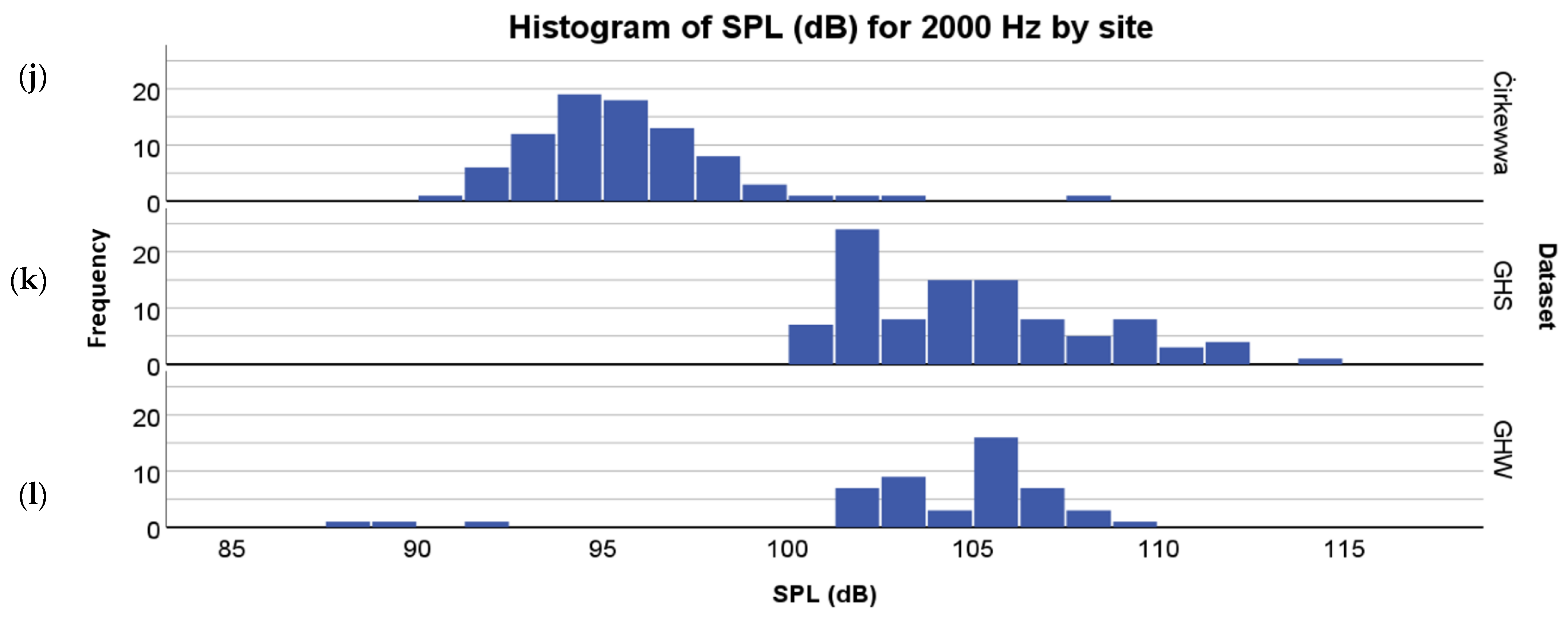
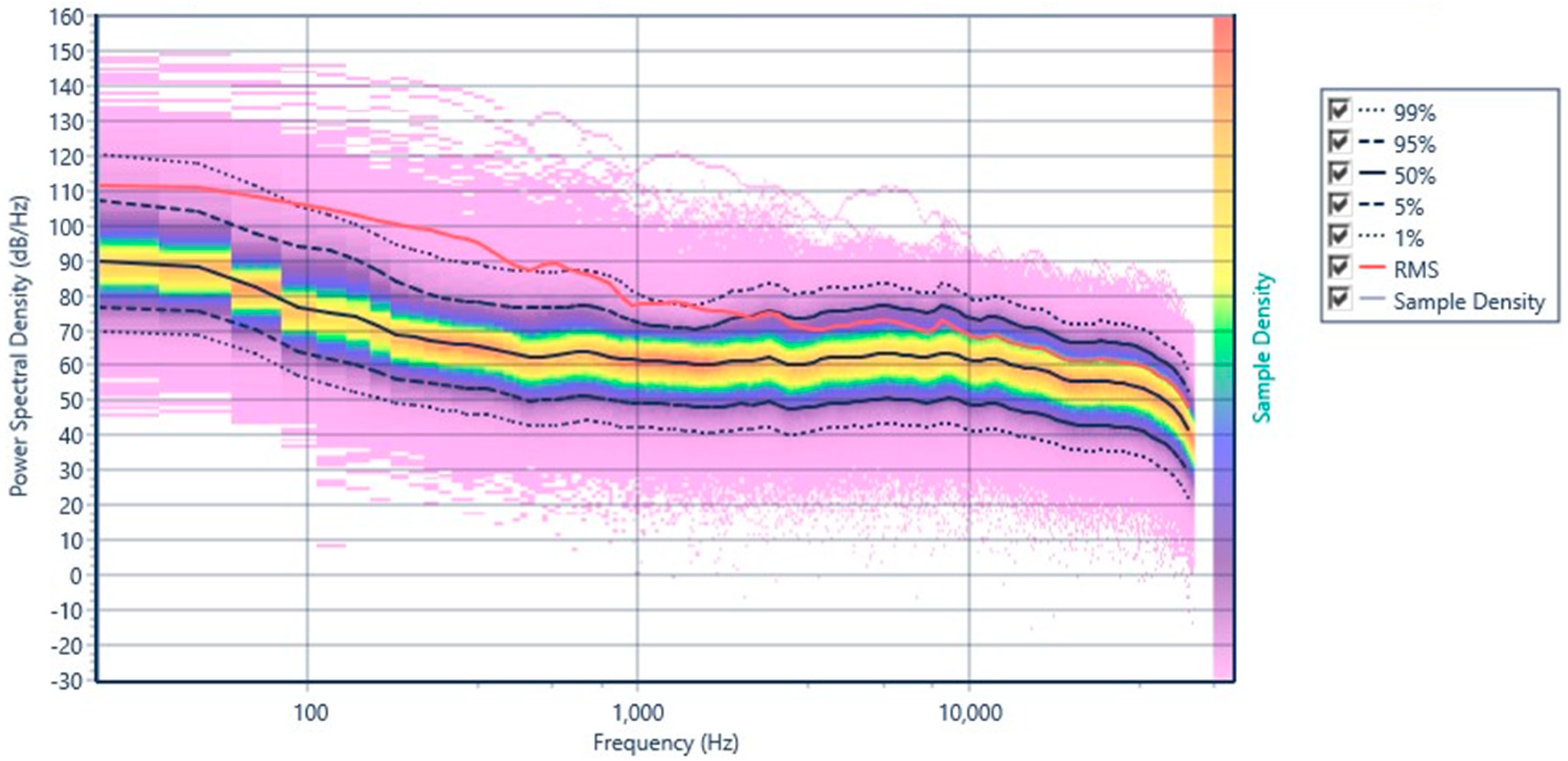
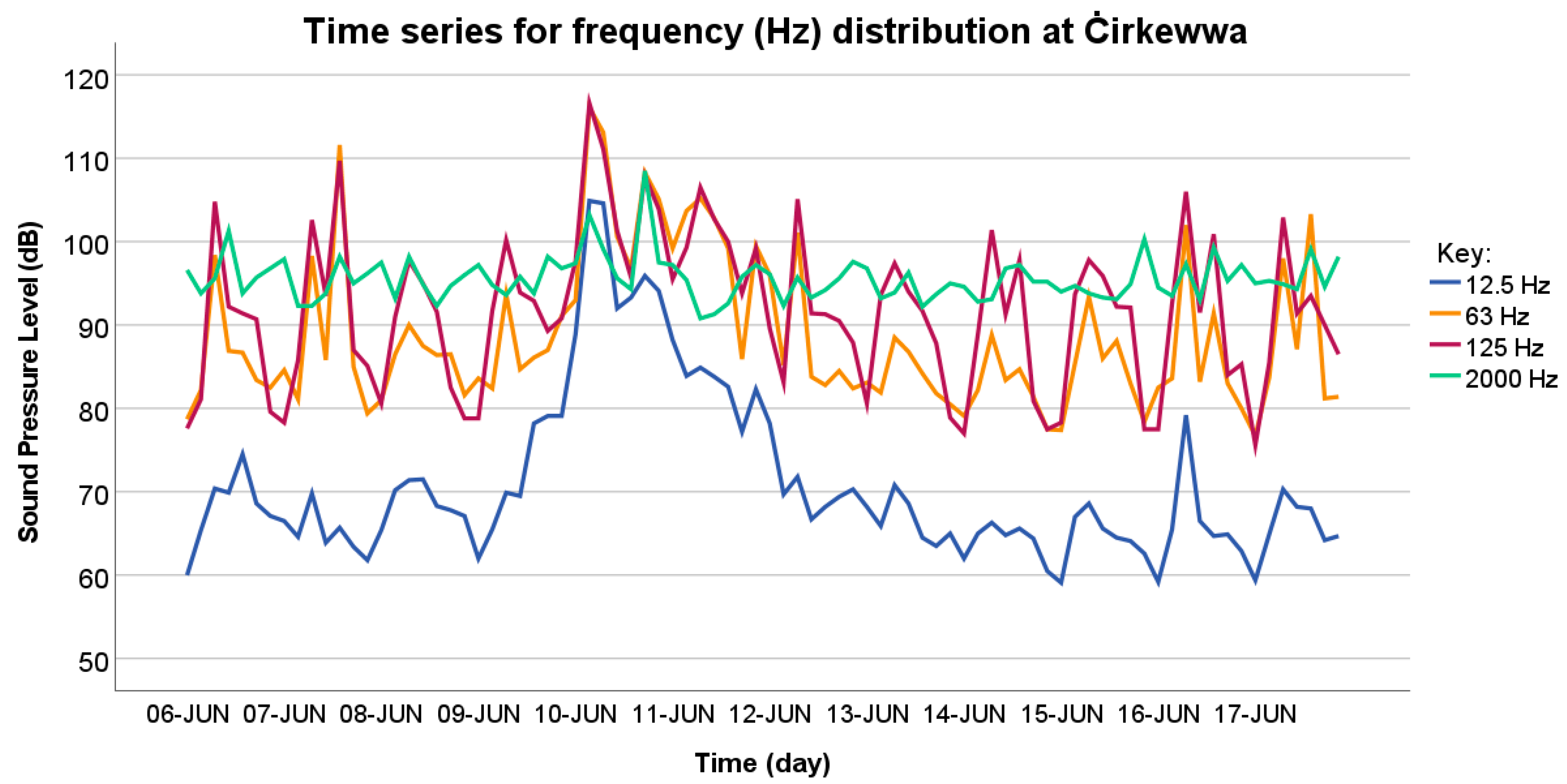
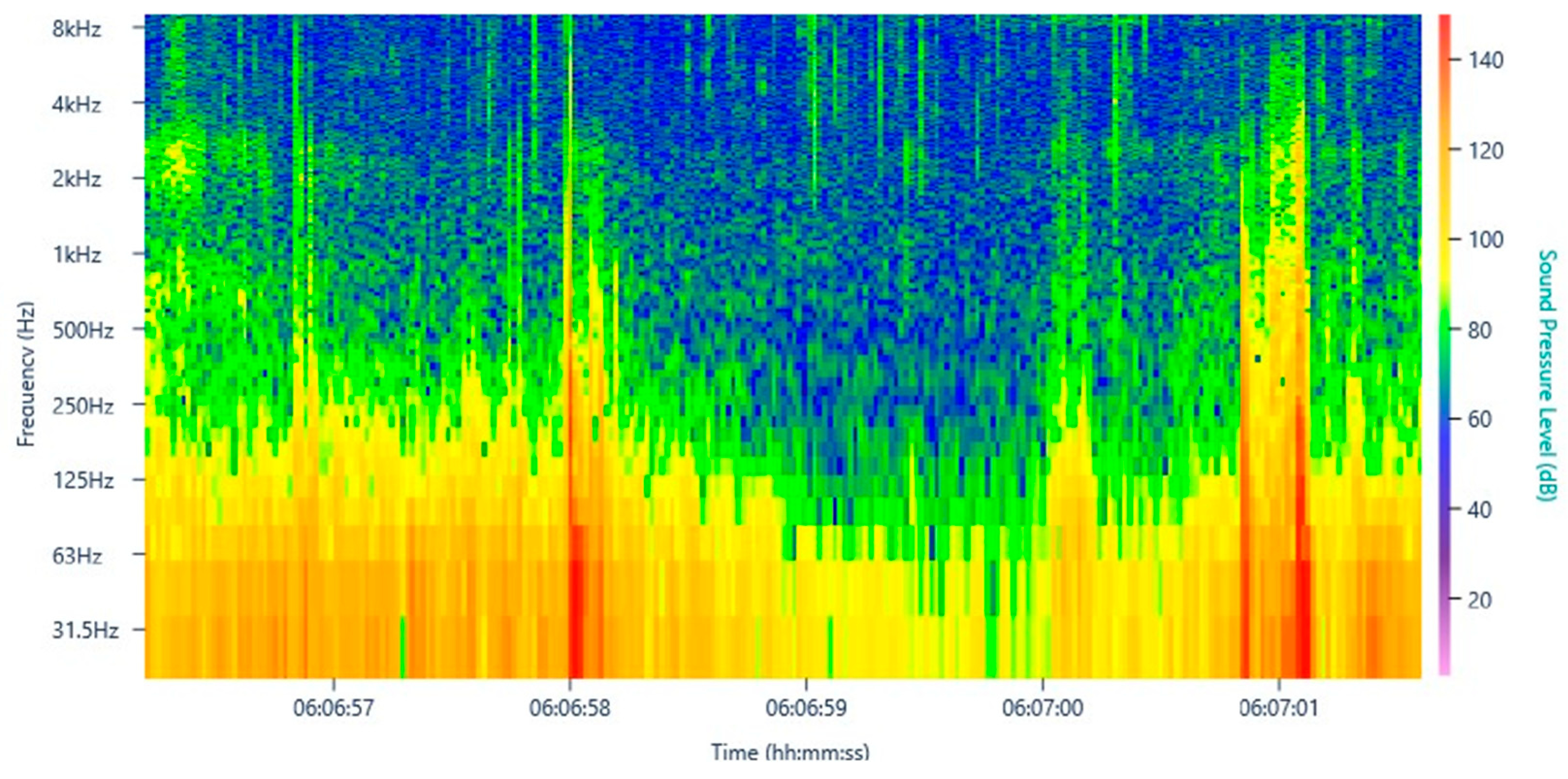

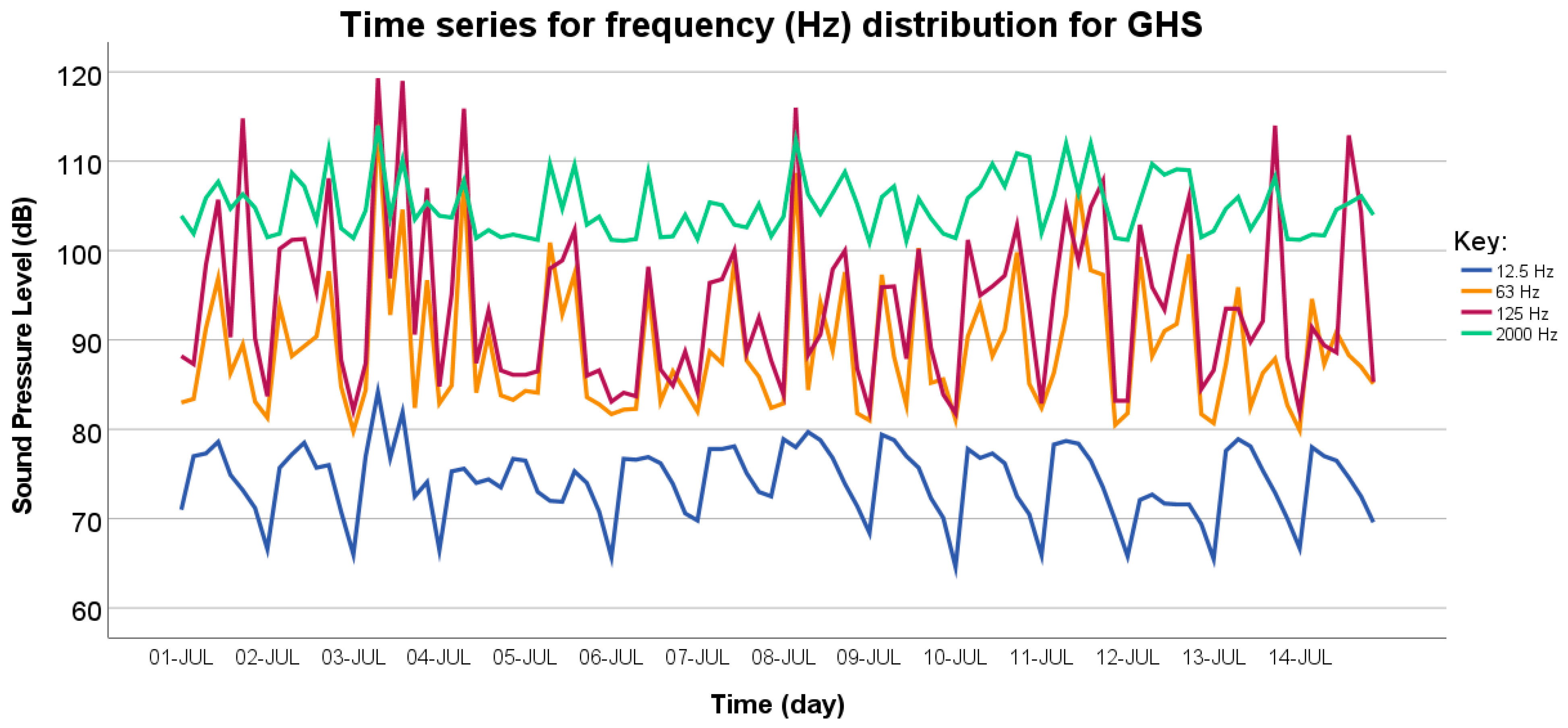
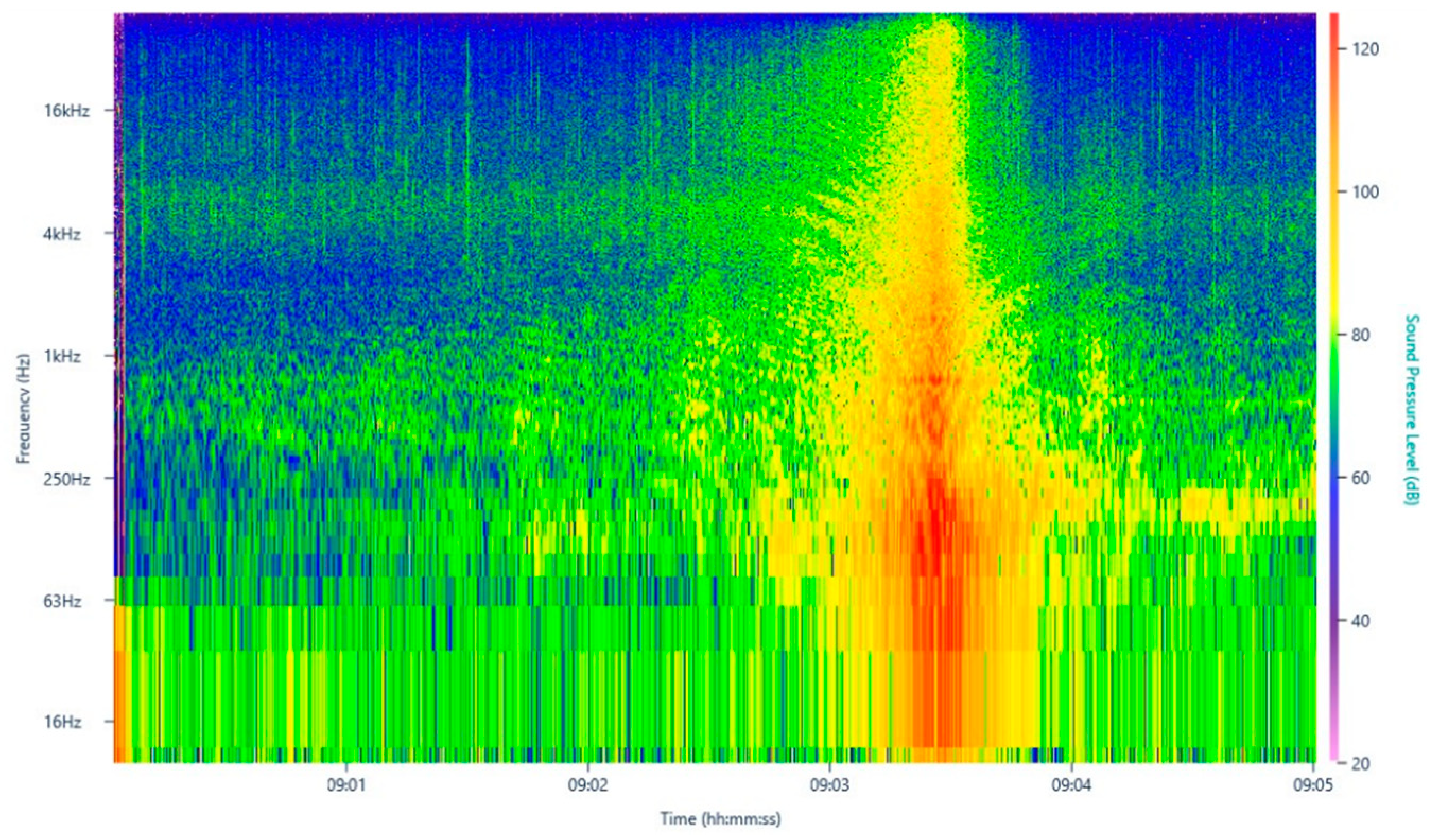
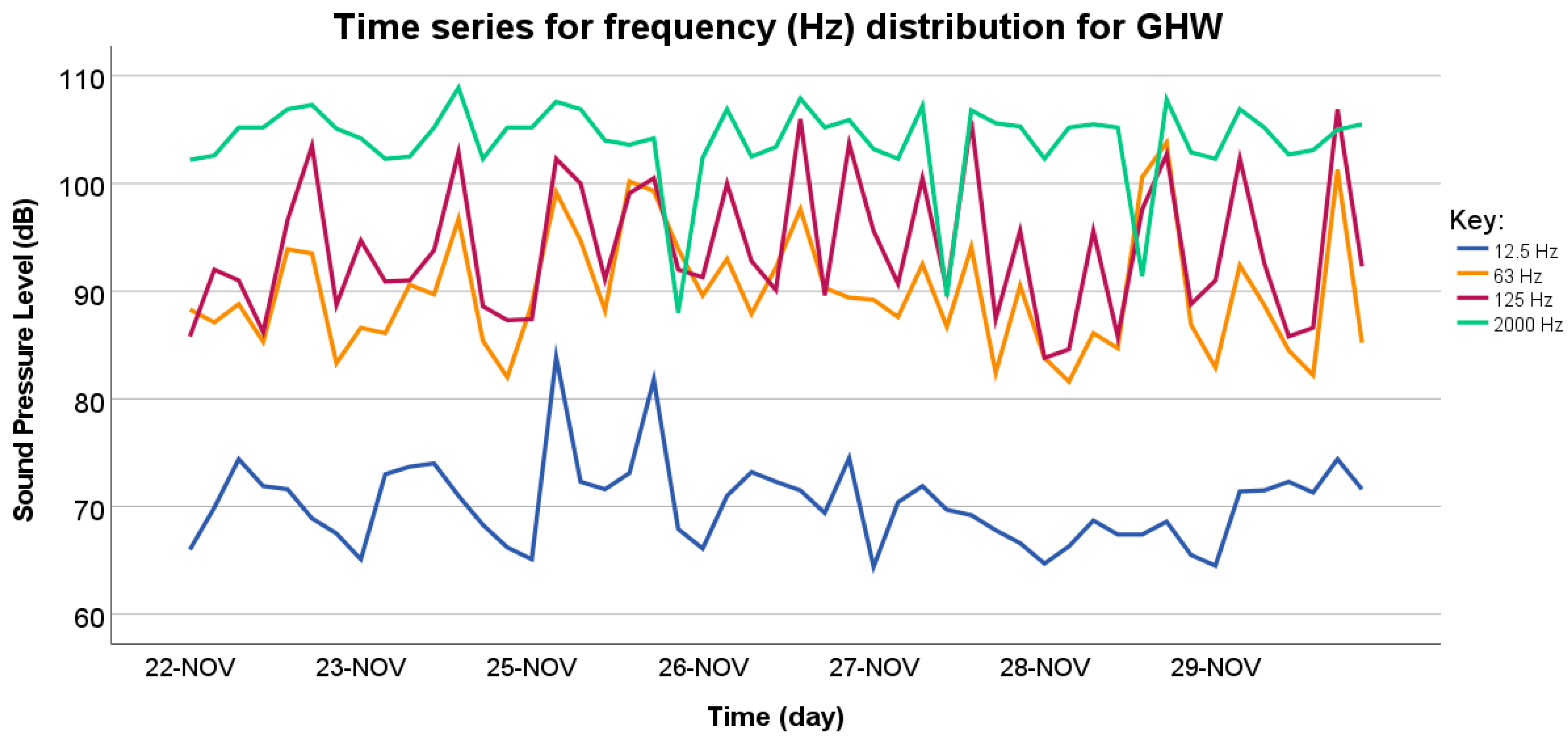
| Frequency (Hz) | Ċirkewwa (dB) | GHS (dB) | GHW (dB) |
|---|---|---|---|
| 12.5 | 70.9 | 74.3 | 70.2 |
| 63.0 | 88.7 | 89.2 | 90.0 |
| 125.0 | 91.8 | 94.2 | 93.9 |
| 2000 | 95.6 | 105.0 | 103.9 |
| Frequency (Hz) | Min. (dB) | Max. (dB) | Mean (dB) | Std. Deviation (dB) |
|---|---|---|---|---|
| 12.5 | 59 | 105 | 70.9 | 9.9 |
| 63 | 76.7 | 116.1 | 88.7 | 9.1 |
| 125 | 75.6 | 116.6 | 91.8 | 9.1 |
| 2000 | 90.8 | 108.5 | 95.6 | 2.7 |
| Ship Hash | Ship Type | Timestamp | Longitude | Latitude |
|---|---|---|---|---|
| 70ef36683b1c429c949c7f809ade705d82f22629edaf68244f0f41d1552b52b4 | 60 | 10 June 2022 05:54 | 14.32963467 | 35.98947906 |
| 70ef36683b1c429c949c7f809ade705d82f22629edaf68244f0f41d1552b52b4 | 60 | 10 June 2022 06:15 | 14.32963657 | 35.98946762 |
| 70ef36683b1c429c949c7f809ade705d82f22629edaf68244f0f41d1552b52b4 | 60 | 10 June 2022 09:00 | 14.3299551 | 35.98982239 |
| be7c52d83c37ee9ca20f0ef7850533e172ca4fccb88b52d49a29f459b36f686e | 70 | 10 June 2022 09:03 | 14.32986832 | 35.98926544 |
| Site and Frequency (Hz) | Min. (dB) | Max. (dB) | Mean (dB) | Std. Deviation (dB) |
|---|---|---|---|---|
| GHS 12.5 | 64.6 | 84.2 | 74.2 | 4.0 |
| GHS 63 | 79.8 | 114.6 | 89.1 | 7.3 |
| GHS 125 | 81.8 | 119.3 | 94.1 | 9.3 |
| GHS 2000 | 100.9 | 114.0 | 104.9 | 3.2 |
| GHW 12.5 | 64.4 | 83.9 | 70.2 | 4.0 |
| GHW 63 | 81.6 | 103.8 | 90.0 | 5.6 |
| GHW 125 | 83.8 | 106.9 | 93.9 | 6.4 |
| GHW 2000 | 88.0 | 108.9 | 103.9 | 4.1 |
| Ship Hash | Ship Type | Timestamp | Longitude | Latitude |
|---|---|---|---|---|
| 263f8e5958a94c15dcdcf259227fa1ccd25e4929b702630f7b6840f06a3af147 | 36 | 3 July 2020 08:53:00 | 14.52294636 | 35.90517807 |
| 02eb631cd4899a949ad088b2f08fd049660ab67623eb37ee07f284b3fa37358c | 36 | 3 July 2020 09:07 | 14.52384853 | 35.90645218 |
Disclaimer/Publisher’s Note: The statements, opinions and data contained in all publications are solely those of the individual author(s) and contributor(s) and not of MDPI and/or the editor(s). MDPI and/or the editor(s) disclaim responsibility for any injury to people or property resulting from any ideas, methods, instructions or products referred to in the content. |
© 2023 by the authors. Licensee MDPI, Basel, Switzerland. This article is an open access article distributed under the terms and conditions of the Creative Commons Attribution (CC BY) license (https://creativecommons.org/licenses/by/4.0/).
Share and Cite
Filletti, J.M.; Gauci, A.; Deidun, A.; Riccobene, G.; Viola, S. A Preliminary Snapshot Investigation of the Marine Soundscape for Malta: A Steppingstone towards Achieving ‘Good Ecological Status’. J. Mar. Sci. Eng. 2023, 11, 2163. https://doi.org/10.3390/jmse11112163
Filletti JM, Gauci A, Deidun A, Riccobene G, Viola S. A Preliminary Snapshot Investigation of the Marine Soundscape for Malta: A Steppingstone towards Achieving ‘Good Ecological Status’. Journal of Marine Science and Engineering. 2023; 11(11):2163. https://doi.org/10.3390/jmse11112163
Chicago/Turabian StyleFilletti, Julia Micallef, Adam Gauci, Alan Deidun, Giorgio Riccobene, and Salvatore Viola. 2023. "A Preliminary Snapshot Investigation of the Marine Soundscape for Malta: A Steppingstone towards Achieving ‘Good Ecological Status’" Journal of Marine Science and Engineering 11, no. 11: 2163. https://doi.org/10.3390/jmse11112163
APA StyleFilletti, J. M., Gauci, A., Deidun, A., Riccobene, G., & Viola, S. (2023). A Preliminary Snapshot Investigation of the Marine Soundscape for Malta: A Steppingstone towards Achieving ‘Good Ecological Status’. Journal of Marine Science and Engineering, 11(11), 2163. https://doi.org/10.3390/jmse11112163





